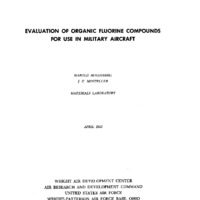-
Title
-
Evaluation Of Organic Fluorine Compounds For Use In Military Aircraft
-
Date
-
1955
-
Index Abstract
-
Online
-
Photo Quality
-
Not Needed
-
Report Number
-
WADC TR 54-580
-
Creator
-
Rosenberg, Harold
-
Mosteller, J. C.
-
Corporate Author
-
Materials Laboratory
-
Laboratory
-
Materials Laboratory
-
Extent
-
22
-
PB Number
-
PB111983
-
NTRL Accession Number
-
AD081163
-
Identifier
-
AD0081163
-
Access Rights
-
OTS
-
Distribution Classification
-
1
-
Contract
-
Laboratory Research - No Contract
-
DoD Project
-
7340
-
DoD Task
-
73404
-
DTIC Record Exists
-
No
-
Distribution Change Authority Correspondence
-
AFWAL ltr
-
Distribution Change Action Date
-
4/19/2004
-
Distribution Conflict
-
Fix
-
Index Price
-
$0.75
-
Index In
-
U.S. Government Research Reports, vol. 25, no. 4, p.146, 4/13/1956
-
Abstract
-
The evaluation of fluorine compounds for use in military aircraft is one phase of a general Air Force program which has been established for the purpose of obtaining materials of unusual properties and capable of advancing the design of new high-speed aircraft and guided missiles. The desirable properties of fluorine-containing organic compounds include wide liquid range, unusual chemical stability, good electrical conduction, desirable heat transfer characteristics and decreased flammability. Fluorine compounds have, accordingly, been studied for use as fire extinguishing agents, acid resistant coatings and greases, non flammable hydraulic fluids, elastomers, electronic equipment and fungicides. For extinguishing aircraft fires, particularly those involving rocket-propellant mixtures, dibromodifluoromethane and bromotrifluoromethane have been shown to be quite effective. Polymers of monochlorotrifluoroethylene and tetrafluoroethylene have been employed successfully as seals, gaskets and in lubricants in aircraft reaction motors and nitric acid-refueling trailers. Various fluorocarbons1 especially chlorofluoroheptenes1 havo been evaluated as snuffer" and antiwear additives for hydraulic fluids. Amongst the "fluoroelastomeric" materials, the poly-l,l-dihydroperfluoro alkyl acrylates have shown the most promise from the standpoint of solvent resistance and low-temperature flexibility. Polyfluoroethylene derivatives have found use in electronic components of military aircraft. Recently, fluorodinitrobenzenes have been shown to be effective agents for protecting fabrics against fungi attack.
-
Report Availability
-
Full text available
-
Date Issued
-
1955-04
-
Provenance
-
IIT
-
Type
-
report
-
Format
-
1 online resource
 WADCTR54-580.pdf
WADCTR54-580.pdf